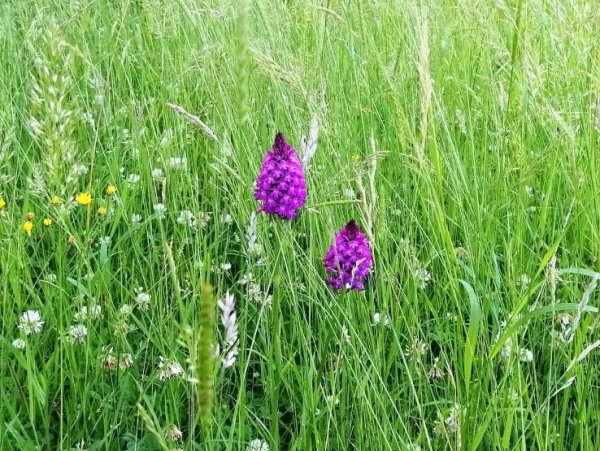Our Wildflower Meadow
One or our members, Rowena Wood, has produced a most wonderful wildflower meadow in her garden without digging it up and sowing seeds from scratch.
Read here about how she did it and the joy it gives.
Around 15 years ago, after many years of cutting a large area of grass in our garden, we were inspired by the number of wildflower meadows being established and decided to stop cutting part of the grassed area and see what happened. We did not want to strip off either the vegetation or the topsoil and sow a mix of meadow grasses and flowers as we very much wanted to echo the local wildflowers which used to be so prolific in the fields around us, but had unfortunately mostly been lost with different farming uses of the land.
Wondrous Yellow Rattle
We started reading about creating a meadow and visited a number of long established meadows run by local Wildlife Trusts and Goren Farm, near Honiton and realised we had to reduce the fertility of the soil to enable wildflowers to establish. And that was when we discovered the amazing power of Yellow Rattle to feed off the nutrients of surrounding grass roots. Traditionally, a field with Yellow Rattle would be viewed by farmers as being very low in nutrients, but this is the environment in which delicate, traditional wildflower species can gradually establish themselves.
Yellow Rattle
What we did
Having roughly scarified a few areas of our grassland, we scattered Yellow Rattle seeds in August, this being the time when the seeds traditionally ripen and drop. The first Spring after sowing, we could see that in the areas where the seed had been scattered, the grass was definitely not growing with the vigour of the surrounding areas. Then gradually year on year, the Yellow Rattle spread out across the meadow area from the original patches which had been sown.
The rewards
With the fertility of the grass reducing each year, the wildflowers and less vigorous grasses have, over the years, increased exponentially. For the first eight or nine years, we were still getting a large number of dandelions, as these are very dominant in the surrounding fields but even these have now become less prominent, but enough of them for early seekers of nectar and pollen. Fifteen years on and the meadow is a delight from early spring right through to early September. If it has been particularly wet in late winter and early spring, we have a large flowering of Milkmaids (Lady’s Smock) and then follows a succession of Bird’s Foot Trefoil, Ribwort Plantain, Yellow Rattle, Lady’s Bedstraw, Meadow Buttercup, Common Knapweed, Salad Burnett, Cat’s Ear, Fox and Cubs and Field Scabious, amongst others. All of these plants just emerged – the seed had evidently just laid dormant for many years but with the fertility dramatically reduced, they burst into growth.
Early May: Common Spotted Orchid leaves appearing
Milkmaids, Buttercups and Cowslips
End of May: Buttercups, Clover and Cow Parsley
Orchids
The most thrilling sight was the emergence of Common Spotted Orchids in one area of the meadow – just five in around the fifth year of starting to allow the meadow to naturalise. And every year, this number has pretty well doubled and in the last two years, pyramidal orchids have also made an appearance. As yet, no Meadow Cranesbill has appeared, which is strange as it used to flourish amazingly well in some of the surrounding fields but maybe this year we may see some. This is one of the joys of the meadow - seeing some new species appear for the first time. And we have very few Ox Eye Daisies but it just shows how different conditions suit different species. There are a number of trees in the lower part of the meadow where the spread of Yellow Rattle has been very slow. This area is shaded by the trees and with leaf drop, even though we remove as many leaves as possible, the ground is far more fertile. This area is colonised by Cow Parsley and Yarrow but gradually as the Yellow Rattle creeps in, the fertility is lowering each year.
End of June: Common Spotted Orchid and Yellow Rattle going to seed
Pyramidal Orchid
Minimal maintenance
Maintenance of the area is minimal. We cut a path through the meadow in April and keep this mown through the summer but that is all the cutting we do until early September, when we cut the hay off the whole meadow area. We turn the hay daily to dry it and then rake and remove it. We then do one further run over the area with a mower in late September, again removing any growth. We stack the hay in a large wire ring and it gradually composts down over the following two years.
Removing the dried hay in early September
Enjoying the results
To walk through this meadow at any time from April to September is an absolute joy – always some new growth to discover and far too much time is spent just watching and hearing all the bees, butterflies, moths and insects collecting nectar and pollen.
So as the new season starts again, I would encourage you to stop cutting just a small area of grassland through the summer, scarify and rake in Yellow Rattle seed in August/ September and watch each year how wonders emerge!
Article by Rowena Wood
NATURE CHAIN would love to hear from you so if you have a little story and some photos about your wildlife gardening, please send it in to thenaturechain@gmail.com






